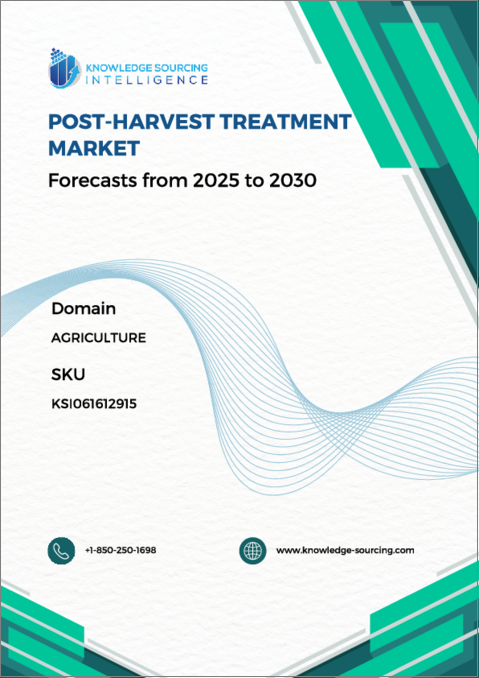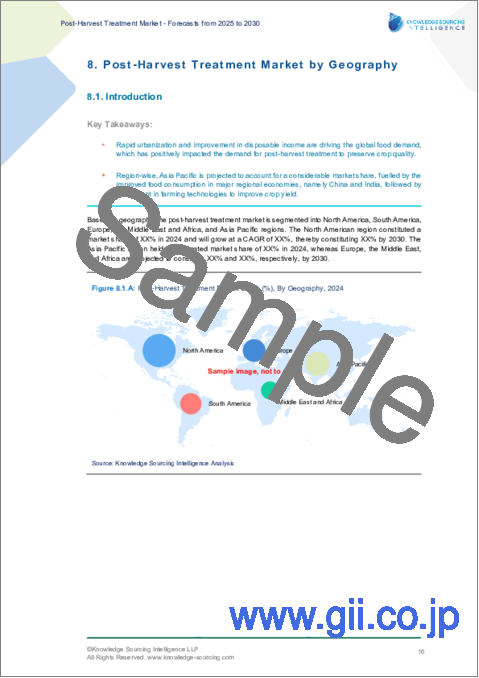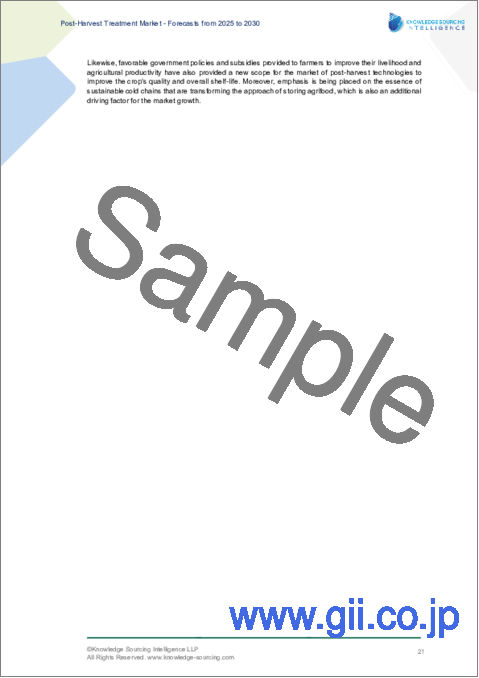|
|
市場調査レポート
商品コード
1627656
ポストハーベスト処理市場:予測(2025年~2030年)Post-harvest Treatment Market - Forecasts from 2025 to 2030 |
||||||
カスタマイズ可能
|
|||||||
| ポストハーベスト処理市場:予測(2025年~2030年) |
|
出版日: 2024年12月10日
発行: Knowledge Sourcing Intelligence
ページ情報: 英文 149 Pages
納期: 即日から翌営業日
|
全表示
- 概要
- 目次
ポストハーベスト処理市場は、予測期間中に複合年間成長率6.75%で成長し、2025年の市場規模19億9,800万米ドルから、2030年には27億6,900万米ドルに達すると予測されます。
同市場は、世界の食品需要の増加により、今後数年間で急増すると予想されます。可処分所得の増加と人口の増加に伴い、清潔で安全な農産物に対する需要が非常に高まっています。国際連合食糧農業機関のデータによると、世界人口は2009年から2050年の間に23億人に増加すると予想されています。さらにFAOの予測では、2050年に推定91億人の世界人口を養うには、2007年から2050年の間に食料生産を約70%増加させる必要があるとしています。
所得と人口の増加に伴い、特に低・中所得国では、高品質の食品を消費する需要が大幅に増加すると予想されます。総農業生産高を高めるための政府の好意的な政策は、市場成長において主要かつ不可欠な役割を果たすと期待されています。さらに、斬新なポストハーベスト処理ソリューションを開発・導入するための研究開発が重視されるようになり、市場需要の向上が期待されています。
ポストハーベスト処理市場の促進要因:
- 農産物貿易の増加
ポストハーベスト処理市場は、世界の農産物貿易の増加により、今後数年間で急成長が見込まれます。1995年の世界貿易機関の創設と開発により、世界的に農産物の輸出入が増加しました。環境問題や水不足などとの闘いに対する課題の増大により、高い食料生産性の解決策に対するニーズが高まると予想されます。この点、インドの主食用農産物の生産はモンスーンに大きく依存しており、農作物の収量は世界のその他の地域よりも低いのが普通です。生産性を低くしている要因は数多くあり、農民の教育や訓練が不十分であること、政府の規制が厳しいこと、非効率的な食品流通システム、インフラの不備(その結果、特定の農産物ではポストハーベスト・ロスが最大40%に達する)、予測不可能な天候、平均的な農地面積が小さいこと(2.7エーカー/1.08ヘクタールと縮小傾向)、植物や動物の遺伝学が不十分であること、国内の農業支援プログラムや補助金が市場のシグナルを歪め、投資を妨げていることなどが挙げられます。これは、ポストハーベスト処理の適用によって一定のレベルまで抑制されています。
穀物・穀類の取引量の増加は市場に好影響を与えています。農家は農業生産高を増やすために斬新なソリューションを採用しています。さらに、大手ロジスティクス企業も、製品の品質を最高に保つためにポストハーベスト・ソリューションの利用を増やしています。こうした開発は、新興国市場の成長に大きな役割を果たすと期待されています。
世界のポストハーベスト処理市場は、世界の5つの地域に区分されます:
地域別に見ると、ポストハーベスト処理市場は北米、南米、欧州、中東・アフリカ、アジア太平洋に分けられます。世界的に生鮮食品への需要が高まっていることから、市場は今後数年で急拡大すると予想されています。また、Institute of Food Technologistsのデータによると、世界の生鮮食品需要はかなりの割合で急増すると予想されています。アジア太平洋、中東・アフリカなどの地域は、人口の増加と所得の増加により、大きな成長を記録すると予想されています。また、有機生鮮食品の消費の急増も市場の成長を後押しすると予想されています。例えばインドは、ほとんどの生鮮果物の市場アクセスを提供しています。消費者層の拡大により、輸入生鮮果実の高品質基準と通年入手可能性にこだわる需要が高まっています。2021年、インドの米国産生鮮果実(リンゴ、ナシ、チェリー、ブルーベリーを含むがこれらに限定されない)の輸入額は2,420万米ドルで、そのうちリンゴが2,250万米ドルと最も高いシェアを占めています。
欧州も生鮮食品の需要を高めると予測されています。新興国輸入促進センターのデータによると、同地域は生鮮野菜・果物の成熟市場となっています。さらに、生鮮野菜・果物の世界貿易額の約44%を占めています。ドイツ、英国、フランスなどの国々が著しい市場成長を示しています。欧州連合(EU)は、世界最大級の農業食品プレーヤーです。EUは、経済的・政策的側面を含め、刻々と変化する環境において強い回復力を示すとともに、生産性の継続的な成長が可能であることを証明してきました。農業部門がその期待通りに環境持続可能性パフォーマンスを向上させるためには、大きな変化を起こす必要があります。この開発は、今後数年間の市場成長を高めると予測されています。
本レポートを購入する理由
- 洞察に満ちた分析:顧客セグメント、政府政策と社会経済要因、消費者選好、産業別、その他のサブセグメントに焦点を当て、主要地域および新興地域を網羅する詳細な市場考察を得ることができます。
- 競合情勢:世界の主要企業が採用している戦略的策略を理解し、適切な戦略による市場浸透の可能性を理解することができます。
- 市場動向と促進要因:ダイナミックな要因と極めて重要な市場動向、そしてそれらが今後の市場展開をどのように形成していくかを探ります。
- 実行可能な提言:ダイナミックな環境の中で新たなビジネスストリームと収益を発掘するための戦略的決断を下すために、洞察を活用します。
- 幅広い利用者に対応:新興企業、研究機関、コンサルタント、中小企業、大企業にとって有益で費用対効果に優れています。
どのような用途で利用されていますか?
業界と市場考察、事業機会評価、製品需要予測、市場参入戦略、地理的拡大、設備投資の決定、規制の枠組みと影響、新製品開拓、競合の影響
調査範囲
- 2022年から2030年までの実績データと予測
- 成長機会、課題、サプライチェーンの展望、規制枠組み、顧客行動、動向分析
- 競合のポジショニング、戦略、市場シェア分析
- セグメントと各国を含む地域の収益成長および予測分析
- 企業のプロファイリング(戦略、製品、財務状況、主な発展など)
目次
第1章 イントロダクション
- 市場概要
- 市場の定義
- 調査範囲
- 市場セグメンテーション
- 通貨
- 前提条件
- 基準年と予測年のタイムライン
- 利害関係者にとっての主なメリット
第2章 調査手法
- 調査デザイン
- 調査プロセス
第3章 エグゼクティブサマリー
- 主な調査結果
- アナリストビュー
第4章 市場力学
- 市場促進要因
- 市場抑制要因
- ポーターのファイブフォース分析
- 業界バリューチェーン分析
第5章 ポストハーベスト処理市場:タイプ別
- イントロダクション
- エチレンブロッカー
- 殺菌剤
- クリーナー
- 消毒剤
第6章 ポストハーベスト処理市場:作物タイプ別
- イントロダクション
- 果物
- 野菜
第7章 ポストハーベスト処理市場:地域別
- 世界概要
- 北米
- 米国
- カナダ
- メキシコ
- 南米
- ブラジル
- アルゼンチン
- その他南米
- 欧州
- 英国
- ドイツ
- フランス
- イタリア
- スペイン
- その他欧州地域
- 中東・アフリカ
- サウジアラビア
- アラブ首長国連邦
- その他中東・アフリカ地域
- アジア太平洋
- 中国
- インド
- 日本
- 韓国
- 台湾
- タイ
- インドネシア
- その他アジア太平洋
第8章 競合環境と分析
- 主要企業と戦略分析
- 市場シェア分析
- 合併、買収、合意、コラボレーション
- 競合ダッシュボード
第9章 企業プロファイル
- Agrofresh
- Decco
- Fomesa Fruitech
- JBT
- Nufarm
- DuPont
- Pace International
- Syngenta
- Bayer
- Xeda International
The post-harvest treatment market is expected to grow at a compound annual growth rate of 6.75% over the forecast period to reach a market size of US$2.769 billion in 2030 from US$1.998 billion in 2025.
The market is expected to surge in the coming years, due to the rise in food demand, worldwide. With the increase in disposable income and the growing population, there has been an immense demand for clean and safer agricultural products. According to the data given by the Food and Agriculture Organisation, the global population is expected to grow to 2.3 billion between the years 2009 and 2050. Moreover, the FAO projections stated that feeding a global population of an estimated 9.1 billion people in 2050 would require the growth of food production by around 70% between 2007 and 2050.
With the increase in income and population, especially in lower and middle-income countries, the demand to consume high-quality food is expected to grow significantly. Favorable government policies to enhance the total agricultural output have been expected to play a major and imperative role in market growth. Moreover, the increasing emphasis on research and development to develop and introduce novel post-harvest treatment solutions is expected to improve the market demand.
Post-harvest treatment market drivers:
- Increase in agricultural trade
The post-harvest treatment market is expected to surge in the coming years, due to the growth in agricultural trade globally. With the creation and development of the World Trade Organisation in 1995, there was a rise in overall agricultural exports and imports worldwide. The increasing challenge to combat environmental solutions, water scarcity, and others, is expected to enhance the need for high food productivity solutions. In this regard, Indian agricultural production of food staples is very monsoon-dependent, and farm yields are usually lower than in the rest of the world. Many factors cause low productivity, including inadequate education and training of farmers, heavy government regulation, an inefficient food distribution system, poor infrastructure (resulting in post-harvest losses of up to 40 percent for certain products), unpredictable weather, small average farm sizes (2.7 acres/1.08 hectares and shrinking), inadequate plant and animal genetics, and domestic agriculture support programs and subsidies that distort market signals and hamper investment. This is curbed to a certain level by the application of post-harvest treatment.
The rise in the trade of grains and cereals has a positive impact on the market. Farmers have been adopting novel solutions to increase their agricultural output. Moreover, major logistics companies have also been increasing the usage of post-harvesting solutions to keep the quality of the products at its highest. This development had been expected to play a considerable role in the market growth in the coming years.
The post-harvest treatment market is segmented into five regions worldwide:
Geography-wise, the market of post-harvest treatments is divided into North America, South America, Europe, the Middle East and Africa, and Asia Pacific. The market is expected to surge in the coming years, due to the increasing demand for fresh foods, worldwide. Moreover, according to the data given by the Institute of Food Technologists, global fresh food demand has been expected to surge at a considerable rate. Regions such as the Asia Pacific the Middle East, and Africa are expected to register significant growth, due to the increase in population and growing income. Also, the increasing surge in the consumption of organic fresh food has been expected to bolster market growth. India, for instance, offers market access for most fresh fruits. In a growing segment of consumers, there is an increasing demand to insist on high-quality standards and year-round availability of imported fresh fruits. In 2021, Indian imports of U.S. fresh fruits (including but not limited to apples, pears, cherries, and blueberries) were valued at $24.2 million, of which apples had the highest share at $22.5 million.
Europe has also been projected to enhance the demand for fresh foods. According to the data given by the Center for the Promotion of imports from developing nations, the region has been a mature market for fresh vegetables and fruits. Moreover, it is also responsible for around 44% of the global trade value of fresh vegetables and fruits. Countries such as Germany, the UK, France, and others, exhibit significant market growth. The European Union is one of the world's largest agro-food players. It has demonstrated strong resilience in an ever-changing environment, including the economic and policy aspects while proving that it can continue productivity growth. Significant changes must be made for the agriculture sector to enhance its environmental sustainability performance as per its expectations. This development has been projected to enhance the market growth in the coming years.
Reasons for buying this report:-
- Insightful Analysis: Gain detailed market insights covering major as well as emerging geographical regions, focusing on customer segments, government policies and socio-economic factors, consumer preferences, industry verticals, other sub- segments.
- Competitive Landscape: Understand the strategic maneuvers employed by key players globally to understand possible market penetration with the correct strategy.
- Market Drivers & Future Trends: Explore the dynamic factors and pivotal market trends and how they will shape up future market developments.
- Actionable Recommendations: Utilize the insights to exercise strategic decision to uncover new business streams and revenues in a dynamic environment.
- Caters to a Wide Audience: Beneficial and cost-effective for startups, research institutions, consultants, SMEs, and large enterprises.
What do businesses use our reports for?
Industry and Market Insights, Opportunity Assessment, Product Demand Forecasting, Market Entry Strategy, Geographical Expansion, Capital Investment Decisions, Regulatory Framework & Implications, New Product Development, Competitive Intelligence
Report Coverage:
- Historical data & forecasts from 2022 to 2030
- Growth Opportunities, Challenges, Supply Chain Outlook, Regulatory Framework, Customer Behaviour, and Trend Analysis
- Competitive Positioning, Strategies, and Market Share Analysis
- Revenue Growth and Forecast Assessment of segments and regions including countries
- Company Profiling (Strategies, Products, Financial Information, and Key Developments among others)
The post-harvest treatment market is segmented and analyzed as follows:
By Type
- Ethylene Blockers
- Fungicides
- Cleaners
- Sanitizers
By Crop type
- Fruits
- Vegetables
By Geography
- North America
- USA
- Canada
- Mexico
- South America
- Brazil
- Argentina
- Rest of South America
- Europe
- United Kingdom
- Germany
- France
- Italy
- Spain
- Rest of Europe
- Middle East and Africa
- Saudi Arabia
- UAE
- Rest of the Middle East and Africa
- Asia Pacific
- China
- India
- Japan
- South Korea
- Taiwan
- Thailand
- Indonesia
- Rest of Asia-Pacific
TABLE OF CONTENTS
1. INTRODUCTION
- 1.1. Market Overview
- 1.2. Market Definition
- 1.3. Scope of the Study
- 1.4. Market Segmentation
- 1.5. Currency
- 1.6. Assumptions
- 1.7. Base and Forecast Years Timeline
- 1.8. Key benefits for the stakeholders
2. RESEARCH METHODOLOGY
- 2.1. Research Design
- 2.2. Research Process
3. EXECUTIVE SUMMARY
- 3.1. Key Findings
- 3.2. Analyst View
4. MARKET DYNAMICS
- 4.1. Market Drivers
- 4.2. Market Restraints
- 4.3. Porter's Five Forces Analysis
- 4.3.1. Bargaining Power of Suppliers
- 4.3.2. Bargaining Power of Buyers
- 4.3.3. The Threat of New Entrants
- 4.3.4. Threat of Substitutes
- 4.3.5. Competitive Rivalry in the Industry
- 4.4. Industry Value Chain Analysis
5. POST-HARVEST TREATMENT MARKET BY TYPE
- 5.1. Introduction
- 5.2. Ethylene Blockers
- 5.3. Fungicides
- 5.4. Cleaners
- 5.5. Sanitizers
6. POST-HARVEST TREATMENT MARKET BY CROP TYPE
- 6.1. Introduction
- 6.2. Fruits
- 6.3. Vegetables
7. POST-HARVEST TREATMENT MARKET BY GEOGRAPHY
- 7.1. Global Overview
- 7.2. North America
- 7.2.1. United States
- 7.2.2. Canada
- 7.2.3. Mexico
- 7.3. South America
- 7.3.1. Brazil
- 7.3.2. Argentina
- 7.3.3. Rest of South America
- 7.4. Europe
- 7.4.1. United Kingdom
- 7.4.2. Germany
- 7.4.3. France
- 7.4.4. Italy
- 7.4.5. Spain
- 7.4.6. Rest of Europe
- 7.5. Middle East and Africa
- 7.5.1. Saudi Arabia
- 7.5.2. United Arab Emirates
- 7.5.3. Rest of Middle East and Africa
- 7.6. Asia-Pacific
- 7.6.1. China
- 7.6.2. India
- 7.6.3. Japan
- 7.6.4. South Korea
- 7.6.5. Taiwan
- 7.6.6. Thailand
- 7.6.7. Indonesia
- 7.6.8. Rest of Asia-Pacific
8. COMPETITIVE ENVIRONMENT AND ANALYSIS
- 8.1. Major Players and Strategy Analysis
- 8.2. Market Share Analysis
- 8.3. Mergers, Acquisitions, Agreements, and Collaborations
- 8.4. Competitive Dashboard
9. COMPANY PROFILES
- 9.1. Agrofresh
- 9.2. Decco
- 9.3. Fomesa Fruitech
- 9.4. JBT
- 9.5. Nufarm
- 9.6. DuPont
- 9.7. Pace International
- 9.8. Syngenta
- 9.9. Bayer
- 9.10. Xeda International





